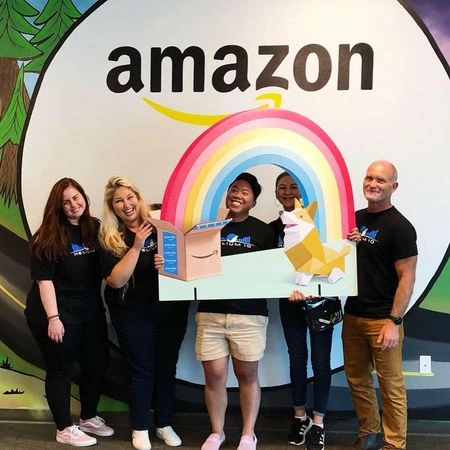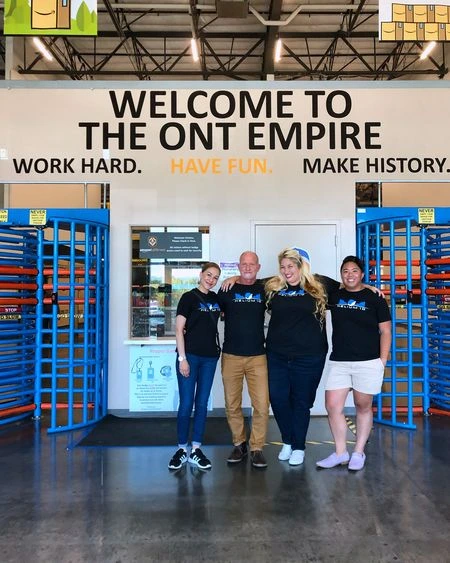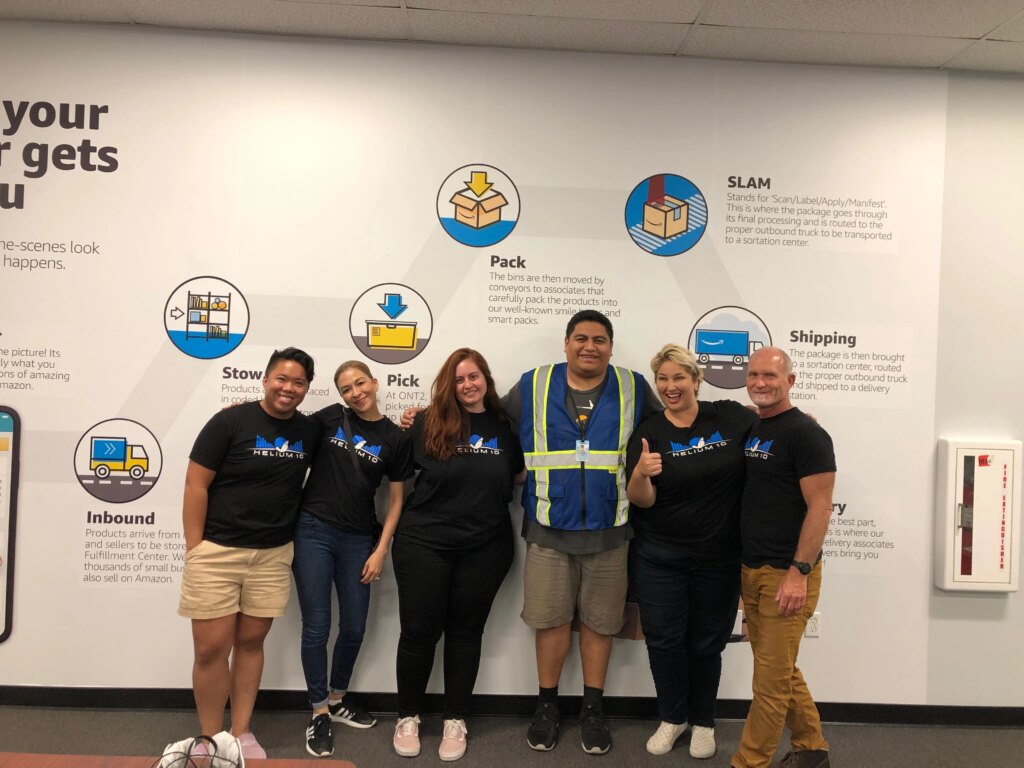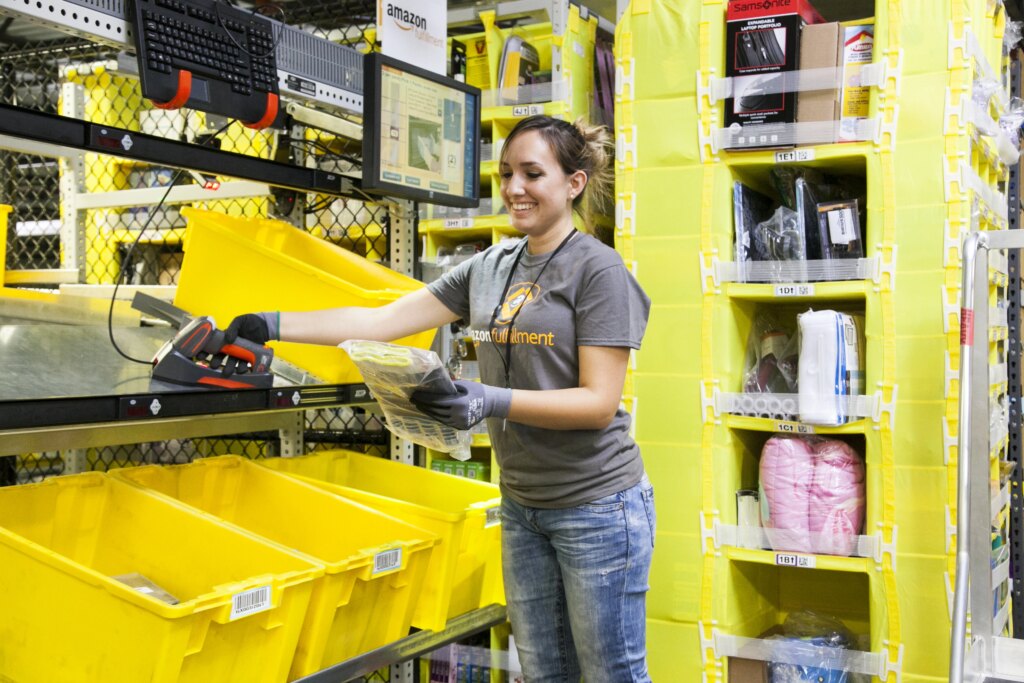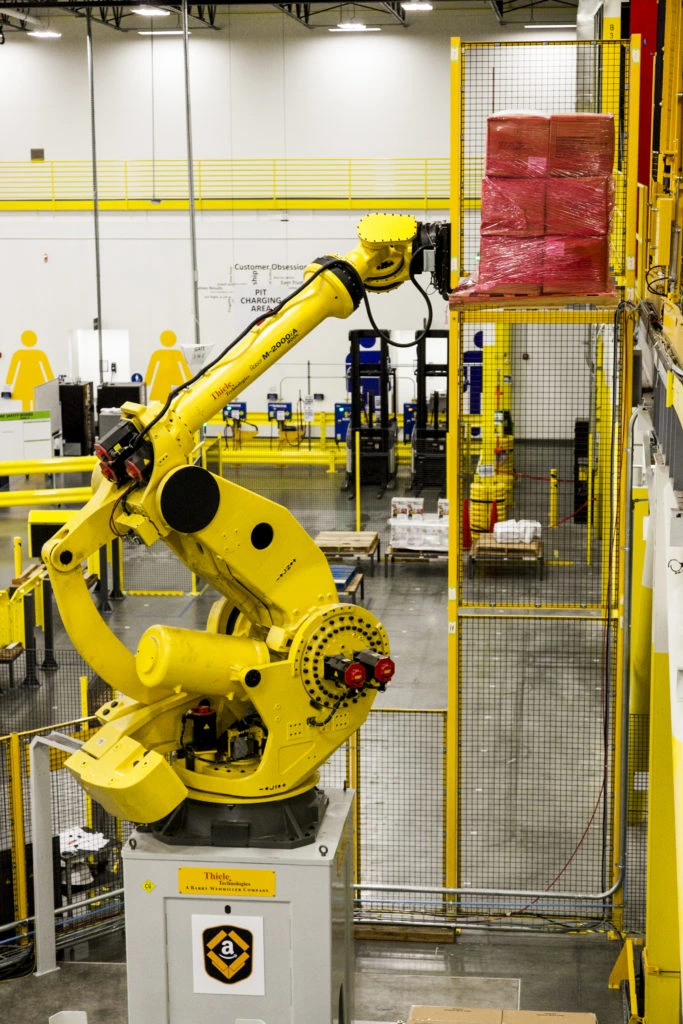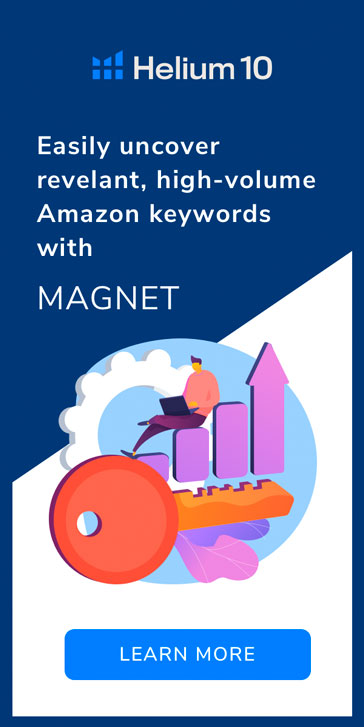Chuck and Kai here. Recently, Helium 10 sent some marketing and content ambassadors/investigative journalists to take an Amazon Fulfillment Center Tour in San Bernardino, CA. Interesting things ensued.
A different sort of fulfillment center
Chuck:
Where I’m from, in Colorado, we have a completely different type of fulfillment paradigm.
The large warehouse spaces that line the I25 corridor as it passes through Denver on its way to Wyoming from New Mexico, as well as the industrial-hip factories that populate the trendy LoDo neighborhoods are not full of Amazon products on their way to expectant customers.
They’re full of legal marijuana.
I once saw footage from a drone equipped with thermal imaging equipment and couldn’t believe the percentage of bright red spots that dotted the downtown area. This was due to the massive usage of interior lighting, which in turn signified grow-houses.
I remark upon this as we drive in spirited traffic through the decidedly non-glamorous landscape that stretches seemingly forever.
Irvine, California, where we started our day, is one of the world’s best planned cities.
People come from all over the world to study the Irvine approach to urban planning.
Present here are all the progressive fundamentals taught at architecture and planning schools: superblocks, pedestrian paths, mixed use areas, integrated landscaping, and public amenities.
It’s also the home of Helium 10.
A small group of us are on our way to the Inland Empire and one of Amazon’s 17 local fulfillment centers.
I started my editor-maddening detour in Colorado because that’s what this reminds me of.
Every time we pass another huge, semi-anonymous warehouse space, we wonder; is that an Amazon fulfillment center?
Because, they are everywhere. OK, maybe not everywhere, but with 17 in this general area alone, it’s never a surprise to see a veritable convoy of Amazon Sprinter vans stream from a huge warehouse at any time.
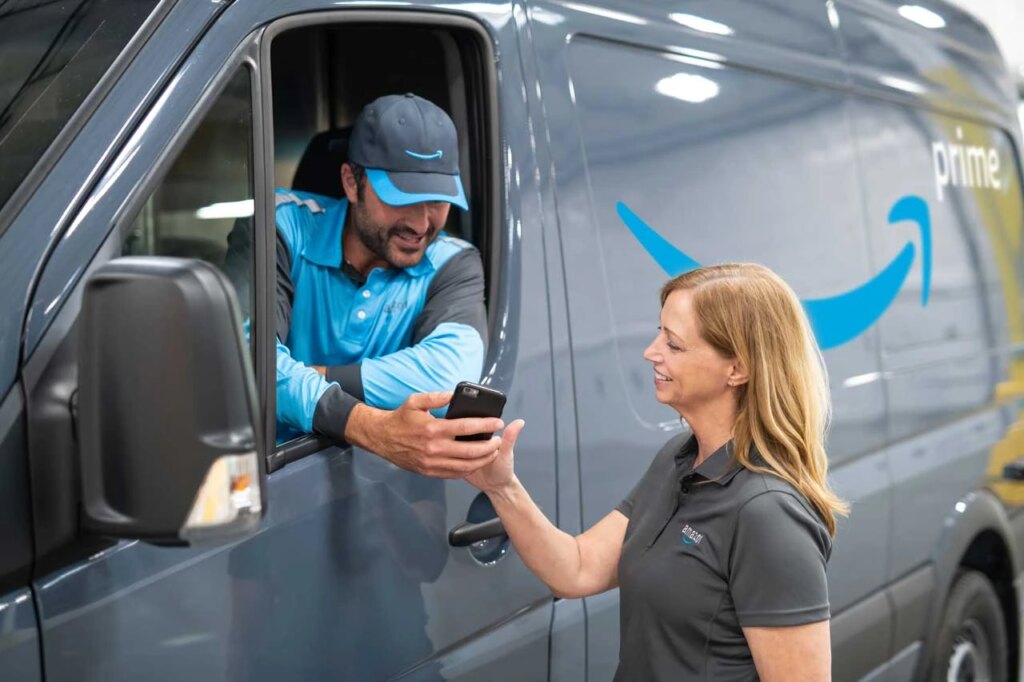
After leaving our car in the expansive parking area, we made our way to the somewhat understated entrance of this, one of Southern California’s two Amazon fulfillment centers that offer guided tours.
When I say understated, I mean that we had the pronounced feeling that somehow we were making a crucial navigational mistake, like going the wrong way through airport security.
A down-scale entrance
But no, Amazon’s entrance, like pretty much everything else that we’d encounter on this tour, was decidedly not upscale.
When we, or I at least, think of Amazon, I imagine being greeted by a hovercraft robot that due to some kind of in-house DNA tracking software, would greet me by name.
Nope, just very friendly uniformed security guards.
In fact that was the overriding feeling of the whole experience; just how normal this admittedly huge warehouse felt.
But first, let’s gather with the rest of the group and take a quick look around at the select assemblage of fellow Amazon fun seekers that are touring the facility with us today.
Select, because spots in these tours are hard to find, like reservations to an upscale haute-cuisine restaurant with a capacity of 20 tops.
Imagine this:
Kai:
It was 101F in San Bernardino that day; just walking through the parking lot felt like a sojourn across the surface of the sun (insert a metaphor here about Amazon being the center of the e-commerce solar system).
This was one of the Ontario fulfillment centers (you may recall your FBA shipments being shipped to an ONT location when creating shipments in seller central), as the text above the security window told us once we stepped inside the lobby: Welcome to the ONT Empire!
This area of SoCal is called the “Inland Empire” (as I learned from being schooled in SoCal geography shortly after relocating here from the Bay Area), so I assumed that was a play on words, never mind the foreboding polarization that the term “empire” instilled.
Actually, apparently “ONT Empire” was meant to be a Star Wars reference, since I soon realized there were miniature cartoonish figures of Stormtroopers and Chewbaccas adorning the beige walls.
I wondered briefly how Disney hadn’t come down on them hard for copyright infringement the way they do if a poor unknowing retail arbitrage seller tries to throw a one-off piece of Disneyana on Amazon; then again, I suppose Disney has smaller fish to fry.
While waiting in the lobby, we were joined by a couple of teachers and their young children, a handful of curious families, and some starry-eyed entrepreneurs. (A couple of the entrepreneurs recognized us, which was awesome!)
Exit, stage left
Our tour guide eventually emerged from an inconspicuous side door behind a banner bearing “#AmazonFCTours” in peppy font. He checked our IDs, signed us off, and then funneled us down a hallway lined with Amazon logos, rainbows, and fun facts about Amazon’s shipping statistics.
The hallway led into a windowless classroom with a TV on one of those multi-shelf stands your teacher would wheel into the classroom when it was movie day (remember those embarrassing outdated educational VHS tapes on puberty we were all forced to watch in 5th grade?). The walls here too were covered with decals calling out more Amazon factoids.
After we’d all filed in and had a good look at the statistics adorning the fluorescent lighting-illuminated walls, our tour guide briefed us on what to expect, with an abundance of assurances that Amazon’s number one priority was safety (by the time he was done name-dropping OSHA terms we were ready to proselytize Amazon’s safety standards as the One True Way).
Then we were given radio headsets (probably Amazon Basics brand) so we could hear our tour guide through the din of 21st-century retail therapy.
Once we emerged into the fulfillment center proper, I was struck by the sheer size of the space … and by how everything was, once again, adorned with Star Wars references. There were banners with X-wing fighters and TIE fighters (I think X-wing was a pun on each “wing” of the fulfillment center), I recall there was a Death Star … even a little cartoonish Darth Vader.
A veritable empire indeed.
Segmentation, refined
We were shown around the various departments of the warehouse. Each department performed a specific stage of the fulfillment process, from receiving to delivery.
We observed loading bays that looked like airport terminals, a labyrinth of conveyor belts and walkways, and sprawling towers of pallets bearing cellophane-wrapped products that were waiting to be received.
A maze of 14 miles of conveyor belts snaked around the center overhead, shooting packages across the space at speeds of up to 20 MPH. It was like having an indoor racetrack, except instead of go-carts they were cardboard boxes secured with precisely-optimized computer-calculated lengths of tape.
Organized chaos
On the ground floor, warehouse associates wheeled convoys of yellow bins (aptly named “totes”) up and down endless rows of product shelves. “Beep beep beep” went their hand-scanners, a continuous serenade of electronic blips; it sounded as if the computers were sentient and conversing with each other (which in a way was true).
What struck me the most about the order the products were stored in for pulling was … well, that there was no order!
When the associates shelved freshly-received product, they didn’t sort them into sections the way a library would sort books according to the Dewey Decimal System. I figured the books would go in one row, apparel in another, toys over there, etc.
No, the warehouse associates literally tossed the products onto whatever the closest vacant shelf was (kind of the way you would clean your room when your mom wouldn’t let you play outside until you could see the floor of your room again).
How did they keep track of where anything was?
Computers!
Associates scanned the FNSKU barcode of each product, then scanned the barcode on each shelf so that their system knew precisely how many units of FNSKUs were on what shelf.
Even my OCD self thought this was quite clever.
So, what’s missing?
Robots. Robots were missing.
We learned that, aside from an oversized stationary robotic arm that helped to lift heavy stuff at this fulfillment center, only about 26 of 175 centers across the US are outfitted with a significant amount of robot assistants.
Despite the fact that the floors weren’t crawling with brigades of Rosies from the Jetsons, the efficiency of every leg of the fulfillment center was clear. Amazon had their processes down to a science, and the integration of technology with human workers was only steps away from actual robotics.
For example, when the packers at their packing stations pulled down one of the “totes” full of product (delivered to them by one of the snaking conveyor belts), a quick scan of the barcode told them precisely what size of box or envelope to use based on the product package’s dimensions.
Remember that Amazon Prime tape that seals every box you receive from Amazon?
A machine at the packing station would instantaneously spit out the exact amount of tape required for each item’s shipping box faster than you could spit out your boss’ questionably-rancid tuna casserole you were obligated to eat at their mandated dinner party.
The packed items would then travel via conveyor belt through a SLAM machine (scan, label, apply, manifest) that scanned an internal barcode and immediately stamped the shipping label onto the box as it passed through.
We’ve come a long way since the days of FBM when you’d be sitting on your living room floor crying during the week leading up to Christmas because you couldn’t place your Zebra printer Stamps.com labels on your outgoing packages quickly enough.
The seamless rapid-fire automation was fascinating … and a little bit eerie. But still fascinating.
Amazon shows what scaling up can really look like
At the end of the day, Amazon simply took a successful and efficient logistics formula … and then exponentially increased its size and reach. It’s the epitome of the “successfully grow your business and 10x your inventory!” mantra, only on a colossal scale (and yes, that is the understatement of the century).
All things considered, the ONT Empire fulfillment center didn’t look that much different from any other logistics center or warehouse–it was just very VERY big. And this was one of the centers without robotics.
Now multiply that center by 175 and spread them across the world. That demystifies the two-day shipping process by a lot, doesn’t it?
How Amazon sellers can learn from this
While Chuck and I hope you’ve enjoyed our soul-searching thought piece, we realize this is the Helium 10 blog and that you need to have some sort of enlightening takeaway as an Amazon seller.
So what’s that takeaway?
Well, for one, it’s that visiting an Amazon fulfillment center is worth the couple of hours out of your day, since it’s entertaining AND educational to see how your FBA inventory gets fulfilled (and also justify why you’re paying those hefty FBA fees).
But more importantly, it’s that Amazon’s already done what you’re trying to do. They took an idea, tweaked it, figured out it was successful and worthwhile, and then scaled it up to incredible proportions to become the e-commerce monolith that it is today.
Amazon sellers like yourself are following in Amazon’s footsteps. They’ve laid the groundwork; it’s up to you to make use of it. That groundwork is like fertile soil (perhaps akin to Chuck’s painting of “fields” of grow houses) waiting to be cultivated into a thriving Amazon business.
Original post from Welcome to the ONT Empire: Helium 10’s Visit to the Amazon Fulfillment Center – Helium 10












